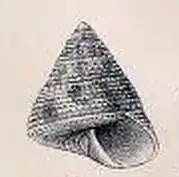Dactylastele burnupi
Dactylastele burnupi is a species of sea snail, a marine gastropod mollusk in the family Calliostomatidae.[1]
| Dactylastele burnupi | |
|---|---|
 | |
| Original drawing of a shell of Dactylastele burnupi | |
| Scientific classification | |
| Kingdom: | Animalia |
| Phylum: | Mollusca |
| Class: | Gastropoda |
| Subclass: | Vetigastropoda |
| Order: | Trochida |
| Superfamily: | Trochoidea |
| Family: | Calliostomatidae |
| Subfamily: | Calliostomatinae |
| Genus: | Dactylastele |
| Species: | D. burnupi |
| Binomial name | |
| Dactylastele burnupi (E.A. Smith, 1899) | |
| Synonyms[1] | |
| |
Description
The height of the imperforate, conical shell attains 14 mm. The shell contains eight, flat whorls with deep sutures. The shell is prettily granulated, the granules upon the base being less pronounced than those above. The thread-like interstices are brown. The oblique aperture is subquadrate. The general color of the shell is a fleshy tint, varied at intervals with brown blotches which are often pale bordered on the left or anterior side. The lowermost row of granules is smaller than those above. This gives the whorls a channeled appearance at the suture.[2]
(Description of Cantharidus bisculptus) The height of the shell attains 10 mm, its diameter 8 mm. The shell has an acute conical shape. It is angulate. The 15 spirals above the angle are much finer than those upon the base. The colour may be variable but in the original greyish white example examined, the brown stripes are divided down the middle by a whitish line. They are slightly undulating and the basal lirae are spotted with the same blackish brown colour. The seven whorls are not quite flat as the rounded keel, which passes above the suture, causes a faint swelling at the lower part. The aperture is subquadrate. The lip is sharp and slightly thickened on the inside. The white columella is slightly arcuate and reflexed. The slight umbilical perforation is sometimes covered by the reflexed columella.[3]
Distribution
This marine species occurs in the Indian Ocean off Mozambique and off Durban, KwaZuluNatal, South Africa.
References
- Dactylastele burnupi (E.A. Smith, 1899). Retrieved through: World Register of Marine Species on 22 April 2010.
- Edgard A. Smith, Descriptions of new Species of South African Marine Shells, Journal of Conchology, v. 9 (1898-1900) (described as Calliostoma burnupi)
- Smith, E.A. (1906) On South African marine Mollusca, with descriptions of new species. Annals of the Natal Government Museum, 1, 19–71, pls. 7–8
- Kilburn, R.N. (1974) Taxonomic notes on South African marine Mollusca (3): Gastropoda: Prosobranchia, with descriptions of new taxa of Naticidae, Fasciolariidae, Magilidae, Volutomitridae and Turridae. Annals of the Natal Museum, 22, 187–220.
- Kilburn, R.N. & Rippey, E. (1982) Sea Shells of Southern Africa. Macmillan South Africa, Johannesburg, xi + 249 pp. page(s): 39
- Vilvens C. (2014). New species and new records of Calliostomatidae (Gastropoda: Trochoidea) from Madagascar. Novapex. Hors-Série 9: 1-29.
- Marshall, B. A. (1995). Calliostomatidae (Gastropoda: Trochoidea) from New Caledonia, the Loyalty Islands, and the northern Lord Howe Rise. in: Bouchet, P. (Ed.) Résultats des Campagnes MUSORSTOM 14. Mémoires du Muséum national d'Histoire naturelle. Série A, Zoologie. 167: 381-458.
- Lussi M. (2014). Description of a new species of Calliostoma from eastern South Africa with notes on the genus - (Gastropoda: Verigastropoda: Trochoidea). Malacologia Mostra Mondiale. 85: 14-19
External links
- "Dactylastele burnupi". Gastropods.com. Retrieved 16 January 2019.
- Smith E.A. (1899). Descriptions of new species of South African marine shells. Journal of Conchology. 9: 247-252, pl. 5
- Herbert D.G. (2015). An annotated catalogue and bibliography of the taxonomy, synonymy and distribution of the Recent Vetigastropoda of South Africa (Mollusca). Zootaxa. 4049(1): 1-98